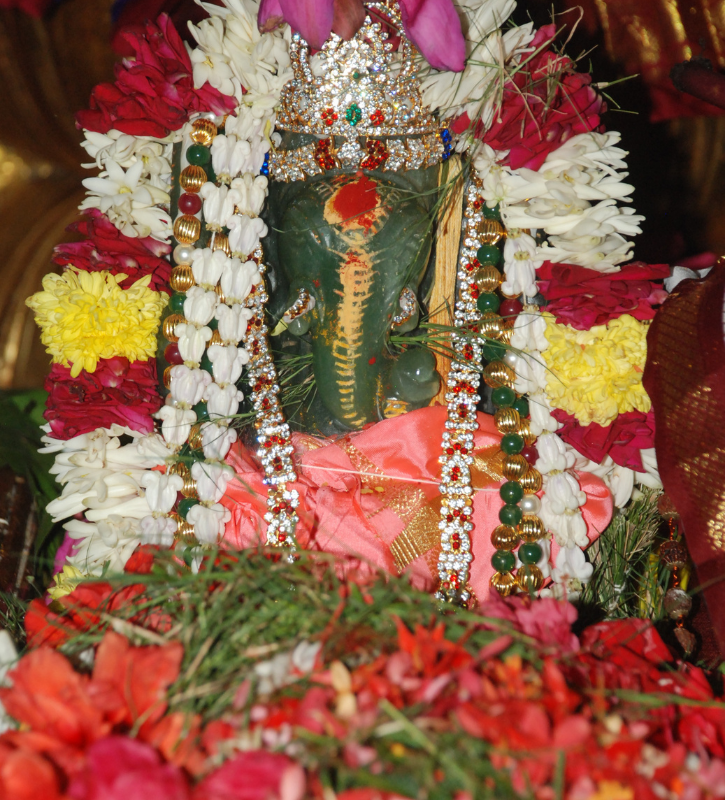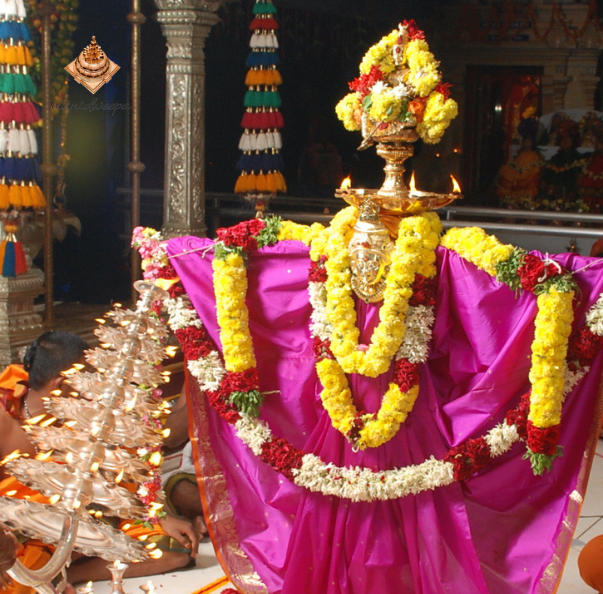Lifestyle Guidelines
It is very good to follow certain lifestyle guidelines during Navaratri, for the sake of maintaining internal and external purity. The following guidelines have been given by Amma so that we can receive the maximum blessings from the practices and also offer appropriate respect and honor to Divine Mother during the blessed time of Navaratri.
Ganesha grants freedom from difficulties, debt, disease, hardship, enemies, and negative karma. Ganesha grants wisdom, vidya (knowledge), nirvana, success and wealth.

– During Navaratri, wake up early and immediately take a head bath (shower and wash the hair). Wear freshly laundered clothes in auspicious colors like white, bright green, red, yellow-gold, turquoise, etc. If possible, it is auspicious to wear traditional clothes like sari or dhoti in cotton or silk.
– It is very important to take only pure vegetarian food during Navaratri. Do not consume meat, fish, eggs, onions, garlic, or mushrooms. Take only light, sattwic (pure and fresh), and easily digestible food. Sattwic food includes dishes like kicheri, ven pongal, vegetables, cereal with organic milk, vegetable sandwiches made with avocado, tomatoes, etc. If you wish, you can just consume fruits, nuts, and organic milk or buttermilk for the ten days. Please consider the state of your health and your nutritional needs, and decide on a suitable diet. Do not smoke or drink any alcohol during the ten days. In addition, it is good to observe brahmacharya (celibacy).
– Some like to follow the practice of sleeping on a hard surface, either a thin mat on the floor or a bed platform without a mattress or cushion. You can sleep on a thin mat or a blanket or sheet. This is good for disciplining the body and cultivating mental detachment.
– Meditation should be finished by 6, and the puja should start at 6. The puja may take from 90 to 120 minutes, and it is very important to complete it once started. Please plan accordingly. It may be necessary to start the puja by 5 or 5:30 to finish it by the time you need to start your daily work.
– Special guidance for ladies: If you are in your menstrual period during Navaratri, you should not do the pujas for the first 4-5 days of the period. In general, during the menstrual period, it is important to refrain from performing puja, visiting temples or attending homas, or touching one’s mala or puja items for the first four days of the period. During this time, many changes take place in the body, mind, and spiritual energy, and the ancient rishis have given some important guidelines regarding this natural process. Rather than do external worship, ladies are advised to do silent meditation and mental recitation of their mantra at home during the first four days. After taking a shower and washing the hair on the fifth day, one’s normal practices can be resumed.
Sadhana Schedule and Details
After completing one’s meditation, the following pujas can be performed starting by 6 AM. The pujas
may take from 90 to 120 minutes, and it is very important to complete the practices once started. Please plan accordingly. It may be necessary to start the pujas by 5 or 5:30 to finish them by the time you need to start your daily work. Before starting the pujas, light a ghee lamp and keep it lit throughout all the pujas.
Sri Ganesha Puja
- Chant Sri Ganesha Pratah Smaranam (page 4).
- Recite the mantra “Om gam ganapataye namaha” 108 times (page 4) while offering green grass to a murti or picture of Sri Ganesha. If you don’t have any image of Sri Ganesha, you can do this puja to your Sri Chakra, as the Sri Chakra can receive offerings for any form of God. If you don’t have any suitable green grass, you may offer red flower petals instead.
- Light two new sticks of incense and offer them to Sri Ganesha (you can gently wave them in front of His image, or slowly move them in a clockwise circle around the image). Make sure not to smell the incense before offering it.
- Offer two bananas as naivedyam (food offering).
- Finally, perform harati with five ghee wicks. If this is difficult, you can offer a single camphor flame.


Sri Lalita Bhavani Puja
- Chant Sri Lalita Pancharatnam (page 5).
- Chant Samputita Sri Suktam while offering milk to a Sri Chakra. If you don’t have any pure and suitable puja vessels, you can use new, unused paper plates and plastic spoons. After finishing the milk abhishekam, gently clean the Sri Chakra with water. Keeping the Sri Chakra in the puja room, pour water over the Sri Chakra until it’s clean and then dry it with a clean paper towel or a new, unused cotton cloth.
- Chant Sri Devi Khadgamala Namavalih while offering silver lotuses, kumkum, or red flower petals.
- Chant Sri Lalita Ashtottara Sata Namavalih (108 Names of Sri Lalita, page 6) while offering kumkum or red flower petals. If you like, you can chant Sri Saraswati Ashtottara Sata Namavalih (108 Names of Sri Saraswati, page 9) on Day 7.
- Light two new sticks of incense (not the same ones previously offered to Sri Ganesha) and offer them to the Sri Chakra (you can gently wave them in front of the Sri Chakra, or slowly move them in a clockwise circle around the Sri Chakra.
- Offer sweet pongal as naivedyam (food offering). If this is difficult, you can offer “panchakarjayam,” which can be made by mixing the following dry ingredients: shredded dry coconut, sugar, cardamom powder, golden raisins, and raw cashews.
- Break a coconut.
- Perform harati with five ghee wicks, while chanting or playing a recording of Sri Mahishasura Mardini Stotram.
Be sure not to throw away any of the items you have offered during the pujas. All offerings become highly charged with divine vibrations and are very sacred. Any flower petals can be given to family or friends to keep in the home, or you can place them respectfully in a clean, natural place outside. Kumkum can be applied to the third eye, and can be given to family or friends, or you can keep it in your puja room to help maintain a very auspicious atmosphere. Any edible prasadam, like the bananas, pongal, or panchakarjayam, should be consumed by you, your family and friends.

